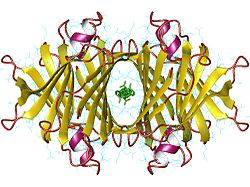Transthyretin
| Transthyretin | ||
|---|---|---|

|
||
| Transthyretin tetramer, human according to PDB 2ROX | ||
|
Existing structural data: s. UniProt |
||
| Properties of human protein | ||
| Mass / length primary structure | 127 amino acids | |
| Secondary to quaternary structure | Homotetramer | |
| Identifier | ||
| Gene name | TTR | |
| External IDs | ||
| Occurrence | ||
| Parent taxon | Vertebrates | |
Transthyretin ( TTR , thyroxine binding prealbumin , TBPA ) is a serum transport protein in vertebrates , which in humans is mainly formed in the choroid plexus and in the liver . It is involved in the transport of thyroid hormones . Mutations in the TTR - gene can Transthyretinmangel and this amyloidosis type 1 or 7 and hyperthyroxinemia cause.
In serum electrophoresis , transthyretin migrates before the albumin fraction ( prealbumin ). It is involved in the binding of thyroxine and retinol and has a molar mass of approx. 55 kDa. In chronic active inflammatory conditions, transthyretin is reduced. It is therefore referred to as an anti- acute phase protein .
In old age, transthyretin is involved in the development of senile amyloidosis ( ATTR amyloidosis ).
Genetically modified variants of transthyretin can lead to hereditary amyloidoses with an autosomal dominant inheritance such as familial amyloid polyneuropathy type I or type II, see. Familial amyloid polyneuropathies .
See also
Individual evidence
- ↑ Homologues at OMA .
- ↑ G. Löffler, PE Petrides (Ed.): Biochemistry and Pathobiochemistry. Springer Medizin Verlag, Heidelberg 2003. 7th edition, pp. 871 ff. ISBN 3-540-42295-1 .
- ↑ UniProt P02766 .